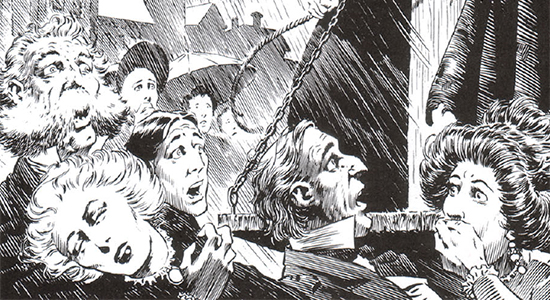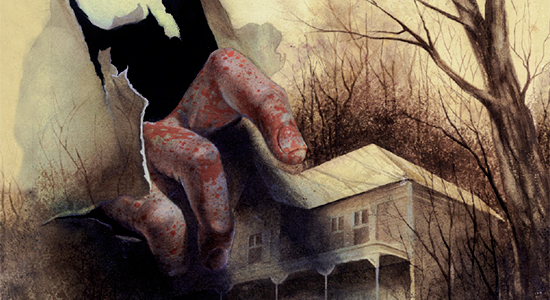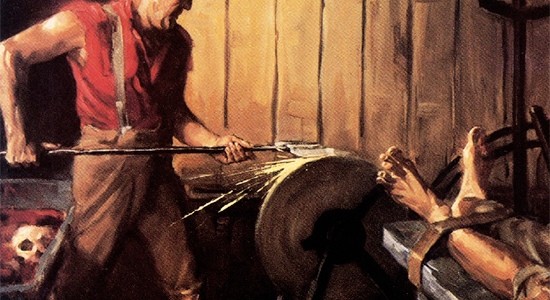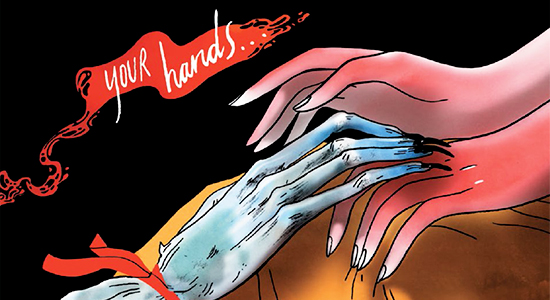
It came from the woods. Most strange things do.
Comic books are commonly associated with superheroes and their costumed adversaries, but the horror genre holds its own rich, often-controversial history within the industry. It was horror comics who were the most swiftly punished by hand-wringing industry guidelines implemented by the Comics Code Authority, who were facing immense media scrutiny thanks to accusations of promoting what was considered to be “immoral” behavior towards impressionable youths and fetishizing violence. Unable to have their product handled by wholesalers unless they were approved by the Comics Code Authority but forbidden by authority guidelines from using the words “horror” and “terror” in their titles, horror comics were left with no choice but to comply with the CCA or else be effectively denied access to a mainstream audience; this later led to the demise of a number of the legendary EC Comics brand’s classic titles like Tales from the Crypt and Vault of Horror.
The genre would experience great change in later years; underground comics by publishers like Kitchen Sink Press emerged in the seventies and gradually grew in popularity, even attracting considerable talent. The Comic Book Legal Defense Fund was formed to assist comic creators and the shops that sold their comics, and the 1982 revival of DC Comics’ Swamp Thing saw renewed interest and vigor in horror comics. The 1993 birth of the Vertigo brand led to the creation of horror comics marketed towards mature viewers, including Hellblazer and Sandman, as well as the anthology collection Flinch (more on that later). Eventually the Comics Code Authority’s literal seal of approval was quietly phased out in 2011.
This list discusses five horror comics from various eras in the industry, from the early-eighties genre revival to modern-day publishing.

BERNIE WRIGHTSON’S FREAK SHOW
Writer: Bruce Jones
Artist: Bernie Wrightson
Publisher: Desperado Publishing, Image Comics
I had the great privilege of meeting comics icon Bernie Wrightson at Houston Comicpalooza in 2016. He was very pleasant and thanked me when I told him I was a big fan, and I bought a signed Batman print from him that is now proudly hanging on my wall. What does that have to do with Freak Show? Not terribly much, but it’s one of my favorite life experiences and I enjoy sharing it whenever I have the opportunity to do so.
Freak Show (sometimes printed as Freakshow) tells the tale of a pious man and his misfits, societal outcasts shunned and abused for their deformities and driven to the brink of suicide—until their savior Valker arrives to take away their knives and their rope in exchange for something precious they’d never before received in their tormented, lonesome lives: hope. There is Deja the Frog-Girl, Robin the Bird-Boy, Posie the Pinhead, Wilhelm the Worm, and a small number of other cast-aways rescued from their misery and brought into the warmth of Valker’s traveling coach, where they all live together as a happy, loving family unit; though they perform in a sideshow under the moniker “Valker’s Wretches”, the spectacles are the only occasion where they suffer the indignities reminiscent of their previous lives. But one day a dark secret of Valkner’s reemerges after having been shamefully locked away for years, so destructive that it led him to devote his life to altruism as a means of balancing the scale and making right the damages of his past wrongs, and begins to chip away at his charitable facade little by little until it bursts through entirely with a sudden, violent roar of fury. He becomes more wretched than any “freak” in his employ, and a familiar path leads him—and the reader—to a shocking ending and a disturbing final page.

FLINCH: THE VERTIGO HORROR ANTHOLOGY
Writer: Various
Artist: Various
Publisher: Vertigo
Published under the Vertigo brand in 1999, Flinch was DC’s modern take on horror anthologies after their past success with series like House of Mystery (which was also later re-imagined by Vertigo) and Weird War Tales (another rebooted by Vertigo, this time for a mature audience). A menagerie of industry figures lent their talents to the series, including Jim Lee, Richard Corben, Garth Ennis, Tim Sale, Bruce Jones, and Greg Rucka. Several of the stories take place in an urban setting and have a nostalgic late 90s/early 2000s feel to them—indeed, one cover features Father Time staring down at the skeletal corpse of Baby New Year emblazoned with a Year 2000 banner—from the characters’ fashion choices down to the now-outdated television sets and boxy computers in their apartments, but it doesn’t detract from the tales’ effectiveness (if anything, it’s more jarring to realize that a character in distress can’t simply retrieve a smartphone from their pocket to contact help).
Thanks to the wide range of talent working on the series, each Flinch issue offers a unique spin on the horror genre. “You’ve Got Hate Mail” is a throwback to the early days of chatrooms (and a grim reminder that sometimes you never really know who you’re talking to online) while “Last Call” reveals the unfortunate results of actually dialing the number listed in seedy “for a good time call…” graffiti, and “The Mule” is a tale of drug-trafficking and the gruesome lengths of a mother’s love. Bruce Timm’s art for “Red Romance” depicts a blood-soaked love that makes Joker and Harley look downright wholesome in comparison, and “Watchful” is a world where the right to privacy has been revoked and society gradually begins to fall apart, too consumed with the lives of others to operate. There are occult themes as well; “The Wedding Breakfast” features a ritual gone wrong, and “Satanic” by Garth Ennis is a rather graphic take on the sinking of the ill-fated Titanic.

SEVERED
Writer: Scott Snyder, Scott Tuft
Artist: Attila Futaki
Publisher: Image Comics
“I tell people I lost my arm in the war. Even my wife doesn’t know the truth. Sometimes the truth is too horrible. But sometimes…sometimes it must be told.”
By the time your brain has registered the above sentence from the first issue of 2011’s Severed, you know you’re going to be in for quite the journey. There’s a terrible truth and an even more terrible lesson to be learned, and if you choose to proceed further then you’ll discover both—but at the expense of whatever remnants of childhood optimism may linger within your consciousness. Severed is by no means a nihilistic piece, and Scott Snyder is far too talented of a writer to craft a story with zero redemption, but it is perhaps the most unflinching of all cautionary tales. It is not enough to simply warn of those who exist only to prey upon the most vulnerable and trusting of our societies—children—for most have heard this spiel countless times before and have become so desensitized to its repetition that to the sheltered and naive, stranger danger is more like lore than a real threat. In Severed the Boogeyman exists, but he does not lurk within the darkness beneath the beds of children; he travels the open road, elderly and unremarkable in broad daylight (his appearance was inspired by serial child killer Albert Fish), and he never deigns himself to hide. He acquires what he wants—who he wants—through handshakes and cunning, and feasts upon the purest of life’s joys until he’s gorged and bloated full: a child’s hopes and carefree dreams for the future.
Most frighteningly of all? He’s always hungry.

TWISTED TALES
Writer: Bruce Jones
Artist: Various
Publisher: Pacific Comics, Eclipse Comics
Controversy is a frequent bedmate of horror comics thanks to the genre’s propensity towards unflinching, graphic illustrations and a rebellious desire to outright challenge the confines of censorship within its stories. But few series have achieved the level of unpleasant notoriety that 1982’s Twisted Tales did with its publication of “Banjo Lessons” in the anthology’s fifth issue, a story that included extremely crass depictions of racism, homophobia, violence, and cannibalism. Editor April Cambell claimed that “Banjo Lessons” was intended to be a mature commentary against bigotry and censorship, but Twisted Tales’ readership widely accused the story of being in poor taste and more sensationalist than thought-provoking, with some consumers going so far as to cancel their subscriptions as an act of protest.
But while the reception towards “Banjo Lessons” was of almost universal disgust, other stories in the Twisted Tales series were quite good, even poignant. “Roomers” is the tale of a feeble elderly man living in a dilapidated apartment infested with cockroaches, suffocated by poverty and his own loneliness, who finds new hope in a spider he befriends. “All Hallows” follows a group of awkward teenage boys crammed into too-small costumes as they go trick-or-treating on Halloween night and are met with fear at every neighbor’s doorstep, and we soon realize that their tradition is a combination of vengeful malice and the loyalty of boyhood friendships. “If She Dies” depicts tragedy so palatable that it feels as if grief seeps from every panel, and was later made into an episode of the 1985 revisioning of The Twilight Zone. A very short story titled “Terminator” seems to have directly inspired the Eli Roth film Cabin Fever, and “Me An’ Ol’ Rex” demonstrates a child’s imagination gone horribly awry.

THROUGH THE WOODS
Writer: Emily Carroll
Artist: Emily Carroll
Publisher: Simon & Schuster
Emily Carroll’s haunting collection of stories is both dreamy and nightmarish, with fairy tale-esque settings that lure the reader in with their soft beauty and apple-cheeked characters, only to shatter the illusion of tranquility by unveiling a ghastly, rotting visage once it’s far too late for the reader to turn simply turn away—suspense is a key theme in every comic, and the only fate more unsettling than whatever may await on the next page is to never know how the story ends at all. One of the comics, “His Face All Red”, was widely popular online prior to being published in this collection, but Through the Woods contains four exclusive stories not available on Carroll’s website (which hosts other excellent works of hers, including “The Hole the Fox Did Make” and the interactive “Margot’s Room”) as well as a prelude devoted to a child’s fear of the dark and a warning of what strange things lurk within the woods, biding their time until your arrival.
“Our Neighbor’s House” is the tale of three rural sisters left to their own devices while their father is away on a winter hunting trip; as the days pass and it becomes increasingly apparent that father has been lost to the heavy snow, panic and bickering begin to set in, until two sisters awake to find the eldest missing—but not before telling her younger siblings of a man who’d come to visit her the night before, tall with a black hat and toothy grin, and feet that left behind no footprints in the creeping, increasingly-suffocating snow. “A Lady’s Hands Are Cold” tells the story of a beautiful young woman in an arranged marriage with a wealthy man, who spends her days idling in luxury among jewels and flowers, and her nights lying awake in terror as a dead wife’s eerie song echoes throughout her bedroom. “My Friend Janna” follows two best friends who feign clairvoyance for seances packed with bereaved fools, but the scheme loses its fun when one begins to actually see a spirit. Finally, “The Nesting Place” is the story of a disabled girl named Bell spending the summer at a countryside cottage with her brother and his new fiance, the bubbly blonde Rebecca, who eagerly attempts to befriend Bell—but Bell soon grows suspicious after learning of a childhood incident involving Rebecca and the surrounding forest, and when she decides to explore the woods for herself Bell makes a disturbing discovery.